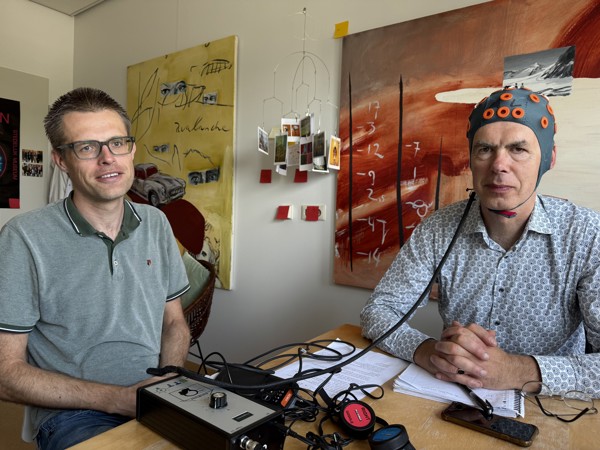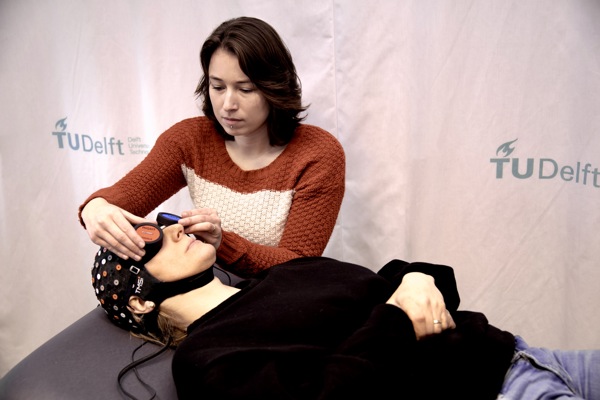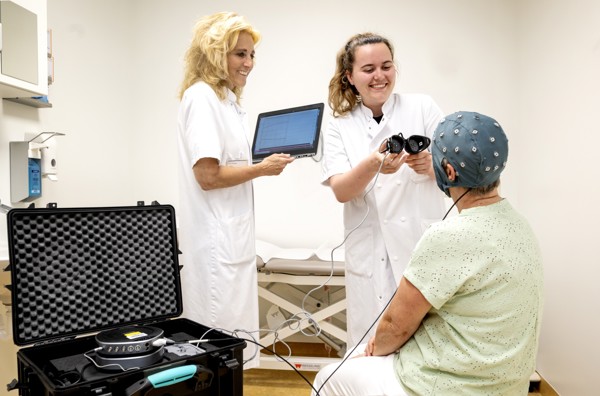Sensitivity to migraine - before an attack even occurs - appears to be measurable using EEG, where electrodes detect brain activity in response to specific light flash patterns. Researchers from TU Delft and LUMC in Leiden are exploring how a user-friendly, at-home device might help migraine patients predict - and possibly prevent - attacks.
By Bruno van Wayenburg. This article was published in Pionering Tech.
“You can try it on yourself if you like,” says Gisela Terwindt, Professor of Neurology at the Leiden University Medical Centre and a specialist in migraine. In her office at the hospital, a sort of swimming cap lies on the table in front of us, embedded with around 30 orange rings positioned to make contact with the scalp. A tangle of white wires extends from it, connecting to a small electronic box.
Once the cap is placed on my head, another gadget is added: a pair of goggles with LED lights on the inside. “Close your eyes,” instructs Mark van de Ruit, a biomedical engineer at TU Delft. After a few seconds, the LEDs begin to flicker, clearly visible even through closed eyelids. The pulses increase in speed—until they suddenly stop.
Avoiding a migraine attack
The cap records an EEG, Van de Ruit explains—a pattern of small electrical signals in the brain. “We aim to develop a method that can predict when someone is especially vulnerable to a migraine attack,” says Terwindt, “so they can take medication in time and avoid known triggers.”
Migraine is a frequently intense headache that may be accompanied by nausea, vomiting, and hypersensitivity to light or sound. “It’s extremely common,” says Terwindt. “One in three women will experience migraine at some point, and 15 percent of men.”
The frequency and severity of attacks vary widely. Some people have only one attack every six months, while others suffer weekly—or more often—from excruciating episodes lasting for days, making normal life impossible.

Triggers can spark attacks
“People often treat it lightly, but it’s a brain disease—just like Parkinson’s or Alzheimer’s,” says Terwindt. “I’m not suggesting that everyone with migraine should see a neurologist, but chronic patients experience a heavy disease burden.” Migraine mainly affects otherwise healthy people who are studying or working, aged between sixteen and fifty—making its societal impact significant.It has long been known that migraines can be linked to and triggered by factors like jet lag, alcohol, lack of sleep, or the relaxation that follows stress. One of the most powerful triggers for women is menstruation.
Detecting migraine attacks in advance
“People often think only of the headache, but there can be warning signs in the lead-up to an attack,” says Terwindt. “Lots of yawning, fatigue, or very hyperactive behaviour with stress or sugar cravings.” This suggests the migraine process begins earlier than the pain phase—and might already be detectable in the brain.
Another clue lies in the so-called aura phenomena, which occur in about one-third of patients before the headache—or even without headache. These include visual disturbances such as flashing lights, zigzag lines, or colourful patterns in parts of the visual field, lasting from five minutes to an hour.
These are caused by discharges of brain cells in visual areas of the brain. The Leiden research group began asking: could there be signs of increased sensitivity—or "excitability"—that could serve as early indicators of an impending migraine attack? Former professor Michel Ferrari initiated a collaboration with TU Delft a few years ago to explore this.

Visual Evoked Potentials-EEG
With VEP-EEG (Visual Evoked Potentials EEG), participants are exposed to specific flashing light patterns, while their brainwaves are recorded using EEG. “We’ve found that the brain is sensitive to flashes at certain frequencies,” says Van de Ruit. “Neurons in the visual cortex (a brain region at the back of the head) start firing in synchrony with the light pattern.”
The stronger this synchronisation, the more sensitive the brain is to stimuli. “Quite by chance, we discovered that people show a stronger response in the 48 hours before a migraine attack,” Terwindt explains. “We found this out by calling participants afterward and asking: ‘Did you experience an attack recently?’”
Although it was a small-scale study with only a handful of patients, the results aligned with findings from other migraine research showing that brain cells respond more strongly to stimuli during attacks. This gives Terwindt and Van de Ruit hope that increased sensitivity to an attack can be detected well in advance.
Situational prevention: acting when it matters
“And that’s where it gets interesting,” says Terwindt. “There are new medications on the market, called gepants, which can be used not only to treat headaches acutely but also to prevent them.” These drugs offer situational prevention: no need for daily medication, but the option to intervene when a person is known to be vulnerable—before the attack begins.
Another benefit could be that patients become more aware of their personal triggers. “We know there are general triggers, but they vary from person to person—so knowing the general ones doesn’t help much. What you really want is to know: can I have a glass of red wine today? Should I take it easy?”
High-risk, high-gain research
The Migraine@Home project aims to test this hypothesis by having people conduct daily VEP-EEG tests at home. Whether this will work remains far from certain, Terwindt and Van de Ruit caution. “Let’s be clear—this is a gamble. It’s high-risk, high-gain research.”
To allow people to perform EEGs independently at home on a large scale, the setup needs to become cheaper, more robust, and more user-friendly. “Ideally, we’d like a simple headband that fits on the back of the head, with a pair of glasses for the light flashes,” says Terwindt.
For a first, small-scale study, the current setup—now lying on the table—is good enough, says Van de Ruit. “It costs thirteen thousand euros, and we have three units. We’re still in the start-up phase, but with ten more of these, we could potentially monitor 150 patients per year.”
Applications for other brain disorders
Only if the results are clearly promising would a larger study be warranted. “For that,” says Van de Ruit, “an EEG device manufacturer would need to develop a version for home use. So far, the market for such devices has focused mainly on clinical and research use in hospitals. Home-use devices would be a whole new market—potentially very interesting for manufacturers.”
Such technology could also benefit other neurological conditions. “At Leiden and Delft, we also collaborate with epilepsy centres,” says Van de Ruit. “Epilepsy is another disorder that occurs in attacks.” Alzheimer’s and Parkinson’s are also common brain conditions. “The brain’s a pretty crucial organ,” Van de Ruit says dryly.
One advantage is that the technology is non-invasive: “No electrodes are implanted in the brain, like with Neuralink’s brain-computer interface.” Those solutions are suitable only for a very small group of patients.
Headache podcast
To support further expansion of the research, better-suited equipment is needed—as is additional funding.
“And we’re always looking for more patients,” says Terwindt, “though we can’t complain about interest. Many people with migraine are active on social media or follow the Hoofdpijnpodcast (Headache Podcast). Migraine sufferers are often very willing to participate in research—even if there’s no immediate benefit for themselves.”
*Available on your favourite podcast app or at www.hoofdpijnonderzoek.nl. One of the episodes, featuring Mark van de Ruit and Gisela Terwindt, discusses the VEP-EEG study.

Migraine@Home is currently funded by the Dutch Brain Foundation and is part of Medical Delta. Migraine@Home contributes to the scientific program Medical Neurodelta, in which scientists from LUMC, TU Delft, and Erasmus MC collaborate closely within the Medical Delta framework.
More information, including stories like that of researcher Mark van de Ruit, is available at: https://www.tudelft.nl/hersenonderzoek
